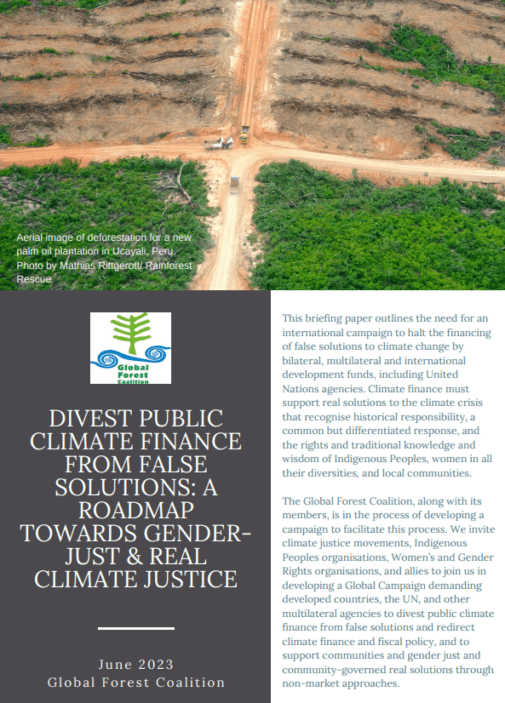On 12 November 2013, the Global Forest Coalition made the following intervention during the negotiations in Warsaw on methodologies to Reduce Emissions from Deforestation and forest Degradation and enhance forest carbon stocks (REDD+):
“The Global Forest Coalition, a worldwide coalition of 54 NGOs and Indigenous peoples’ organizations promoting rights-based forest policies shares the concerns of our NGO and IPO colleagues about the extremely weak draft decisions that have been developed in the areas of drivers of forest loss and safeguards. We particularly wonder what we are doing here if this body, and the REDD+ mechanism it is designing, is not capable of addressing the real drivers of forest loss, most of which are linked to international commodity trade. Frankly, if REDD+ is not about addressing the real drivers of forest loss, we don’t think it is a mechanism that should be supported. So we strongly urge governments to focus on developing more effective non-market based approaches to address the international drivers of forest loss, and if they feel they cannot do that within the framework of the REDD mechanism, we urge them to do so within other Frameworks for Various approaches.”
The text that was adopted by the 19th Conference of the Parties of the UN Framework Convention on Climate Change on the drivers of forest loss is without doubt the weakest text any international forest-related body has ever adopted on this issue. The negotiators could at least have had the decency to refer to the far more elaborate Proposals for Action and recommendations on addressing the underlying causes of forest loss the Intergovernmental Forum on Forests and the Parties to the Convention on Biodiversity adopted 13 resp. 11 years ago. The REDD+ drivers text does not include any reference to the broadly recognized fact that the most important drivers of forest loss are linked to international commodity chains, and that these drivers will per definition lead to transboundary leakage of emissions if actions to address them are implemented at the national supply-side level only. Such transboundary leakage can already be detected as a result from the Brazilian efforts to reduce forest loss in neighboring countries like Paraguay and Colombia, where both soy expansion and the expansion of large-scale cattle ranching is mainly driven by Brazilian immigrants, and the massive leakage of emissions caused by the Chinese logging ban. For the climate, this means there is no positive result of such supply-side measures, but the countries themselves will be able to claim results-based payments, which is exactly what motivated a country like Brazil to suddenly become a pro-REDD champion. And please note it was Brazil that played the key role in derailing the REDD negotiations in 2012. To what extend the recent Norwegian contribution to the Amazon fund has played a role in buying their support for the 2013 deal can only be guessed, admittedly the clumsy EU suggestion in 2012 that middle income countries would not need financial support for REDD+ policies also caused the negotiations to turn sour in Doha. It is clear that REDD+ was always a profitable deal for Brazil, provided they have full and unlimited access to the funding.
Meanwhile, none of the big forest countries had any interest in a REDD+ decision that hinted at taking demand-side action to address the drivers of forest loss, even though reducing demand for key commodities is the only way to reduce forest loss without causing leakage. Especially biofuel policies provide a lot of opportunity for reducing commodity demand (as the demand is artificially created in the first place) but they are a red flag, especially for Brazil and Argentina, which acted fast to kill any reference to demand-side measures in the drivers text in June 2013. The chairs of the negotiations and many other countries were fine with this, in fact, one of the co-chairs stated openly at an NGO briefing in June that he felt that “drivers are better addressed somewhere else”, and not in the REDD+ mechanism. In fact, GFC itself already concluded in its latest report on REDD+ and the underlying causes of forest loss (
https://globalforestcoalition.org/wp-content/uploads/2013/11/REDD-and-UC-report-final.pdf) that through its focus on national results-based payments REDD+ is per definition not the right mechanism to address the main drivers of forest loss. We also found that in the countries we analyzed (Brazil, Colombia, Uganda, Tanzania and India) the REDD+ policy discussions had not lead to any concrete measures to address the main drivers of forest loss in practice, even in the cases where they had been identified in the readiness process.
The Coalition of Rainforest Nations, as usual totally dominated by PNG as many of its members are not able to follow the (English….) negotiations themselves, Norway (especially trying to convince its own new government its billions were not wasted) and key other countries, including the Philippines as co-chair of the working group, had very strong financial interests to get any kind of deal on REDD+ as well. Sadly, the EU was coordinated on this issue by a country with at least as much interest in REDD+ offsets as Norway, namely the Netherlands – quite fascinating how two of the biggest fossil fuel producers in Europe played such a big role in these negotiations. So there was a strong willingness to agree on any kind of text, including on issues like MRV, reference levels and safeguard information systems, where countries are more or less free to provide any kind of information according to any kind of system they want, with only some vague principles and a rather non-sensical verification system to guide them on reference levels and MRV. In our report on the REDD+ negotiations in June we already classified the emerging package of REDD rules as the “Whatever Approach” (See:
https://globalforestcoalition.org/wp-content/uploads/2013/06/Forest-Cover-no43-June-2013-final.pdf). All the REDD decisions adopted are pathetically vague and non-sensical from a legal point of view, using clauses like verifications that “might” happen, technical assessments that should be limited to “facilitative, non-intrusive exchanges”, and “summaries” of information on things as important as safeguards without any further guidance. Frankly, such texts are an insult to international law. Especially the weak decision on reference levels will lead to REDD+ contributing very little to additional emission reductions. Of course, there is a clear relation between the weakness of the reference level text and the weakness of the drivers text: If drivers remain unaddressed at the demand side, this inflates the baseline, and makes it possible for countries to demand far more funding to reduce forest loss.
So REDD+ has been developed as a mechanism that will not address the main drivers of forest loss. In fact it provides an incentive for the international community not to address demand-side drivers. Due to the ‘whatever approach’ it has taken to its own rules there is a great risk it will not contribute anything to mitigating climate change, in fact, if REDD+ would be financed through offsets it would seriously undermine the climate regime. The safeguards and safeguards information systems discussion has taken up a lot of attention from the NGO community following the negotiations, but only in countries where the NGOs and especially Indigenous peoples were able to put a very strong fist on the table, like Indonesia, these safeguards have provided instruments for some positive policy measures. In most other countries (like Paraguay), the NGO and IPO community is far too weak to promote or even monitor their implementation, and as a result the Government will be able to provide any kind of artificial information in its “summary” on how it has implemented the safeguards.
Last but not least, REDD has been developed as a results-based payment system with a small but quite significant omission: It is as yet not defined who or what will actually pay for the results. The fact that the REDD+ mechanism was adopted at the darkest and most unproductive Conference of the Parties the UNFCCC had even seen is significant for the real intentions of the mechanism, which was developed by a small group of isolated negotiators that seemed untouched by the drama’s that took place in the other negotiations, which ranged from tears and hunger strikes to walk outs by country negotiators and most of the NGOs. However, the lack of a clear financial agreement on what was previously announced as “the finance COP” will have very serious consequences for REDD as well. In fact, contrary to all existing international forest policies, REDD+ is 100% dependent on financial support. It is always easy to talk about ‘other people’s money’, and this is precisely what the REDD negotiators did when they mainly referred to the Green Climate Fund as having a “key role” as the potential source for results-based payments. Alas, finance negotiators have proven to be less interested in REDD+ than REDD+ negotiators interested in finance; when the Board of the Green Climate Fund discussed its priorities earlier in 2013 REDD+ was chosen as 1 of the 14 results-based areas only, side by side with entirely independent “sustainable forest management” and “sustainable land use” areas, making it clear that REDD+ is only one of the forest-related policy areas to be funded. More importantly, this fund remained basically empty in Warsaw, which rather saw a controversial declaration by the US that it expected most of the 100 billion USD that was promised by the developed countries in 2009 to come from the private sector. The EU had already clarified in 2010 that it did not expect more than 40% of this 100 billion to consist of public support from the developed countries to developing countries. A quick calculation (40/14 results-based areas) learns that public funding levels for REDD+ should not be expected to rise significantly above current levels of readiness support, and this is in the very best case scenario that the 100 (or rather, 40) billion commitment is ever fulfilled. According to the EU a remaining 40% is supposed to come from the private sector, but according the latest State of the Forest Carbon Market report forest carbon offset markets have already declined with some 20% since 2011 and Conservation International recently calculated that supply of REDD+ offsets on the carbon markets is currently some three times higher than demand. More importantly, a small victory for the climate justice movement and countries concerned about carbon markets in the dark Polish days was that negotiations on a new market mechanism were postponed due to profound disagreements about the need for an evaluation of existing market mechanisms before such a new one is established. It is not yet sure whether agreement on a New Market Mechanism will be reached before 2015 at all.
Meanwhile, other forest policies continued to gather momentum at the Warsaw COP. They are explicitly mentioned in the decision on results-based finance, and influential events like the Global Landscapes Forum showed clear support for holistic, integrated policies that fully take into account the many non-carbon benefits of forests, and the interactions between different types of land use. Here again, the REDD+ mechanism simply does not provide the right incentives for such holistic approaches as its financial incentives target carbon benefits only, with non-carbon benefits being at most something to ‘take into account’ as it is suggested they make the carbon-oriented approach of REDD+ easier to implement. Alternative non-market based approaches like the joint mitigation and adaptation approach proposed by Bolivia seem far more in line with the outcomes of the Global Landscapes Forum, and while these are still to be developed, they could very well provide a better framework to address international drivers of forest loss as well. These approaches also do not pretend to be 100% finance-dependent, which is not unimportant in light of the bleak financial outcomes of Warsaw.
In summary, this pathetic REDD package deal might as well mark the beginning of its end.








